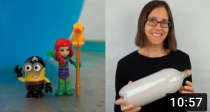Parental supervision is recommended if repeating some of these experiments at home.
- Salt is made of Sodium and Chloride ions. What happens to the ionic bond between Sodium and Chloride when it is added to water?
- Which can hold more solute, hot water or cold water? Why? Hint, when water cools down molecules slow down.
- We learned from the video that one cup of water became saturated with 3 Tbsp. of salt, 1/2 cup of Alum, and 1/4 cup of Borax. How much sugar was one cup of water able to hold before it was saturated? Why was that?
- If you tried some of these activities, how did it go? Pictures and summaries are always fun for us to see and read.
Earn badges and qualify for prize drawing by registering and answering journal questions. It's fun and easy!


